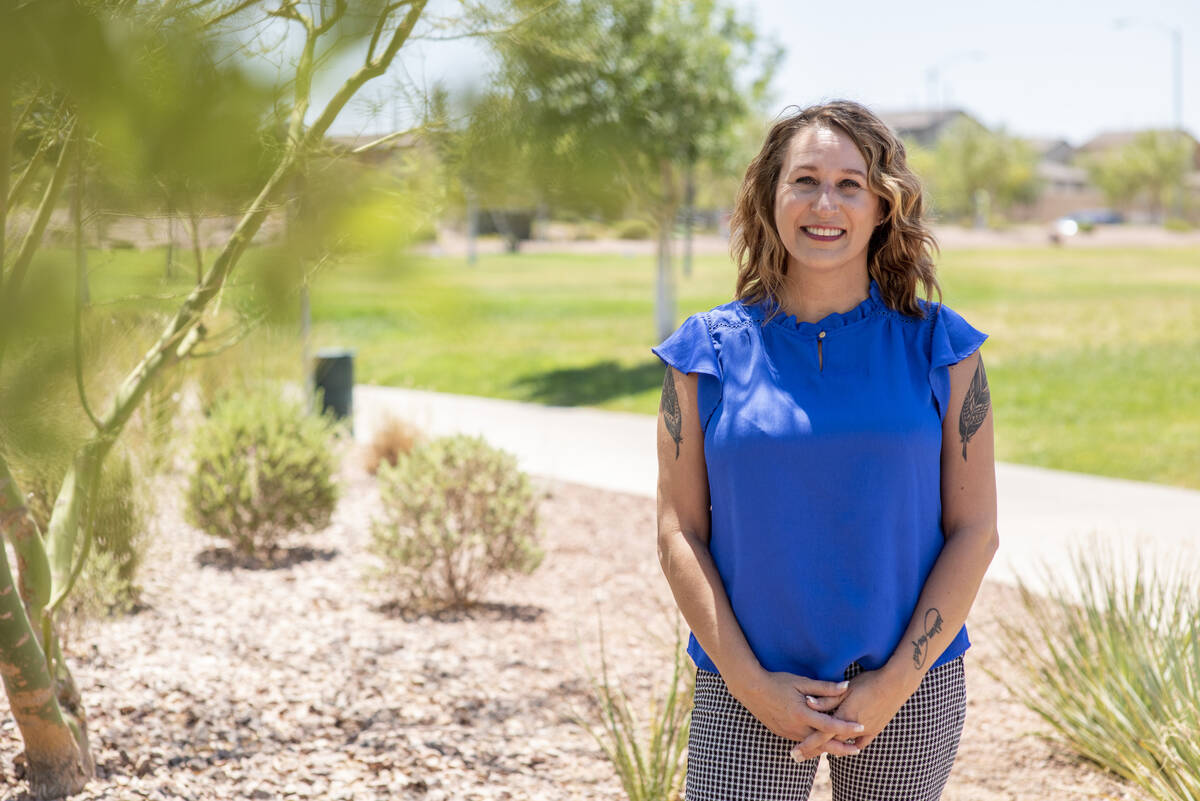CCSD families struggle with school zone variance changes
Cecia Alvarado’s daughter is going into her senior year of high school, but isn’t registered yet.
That’s because she doesn’t know which school she’ll attend when Clark County School District classes begin Aug. 8 — just three weeks away.
Alvarado’s daughter has attended Palo Verde High School in northwest Las Vegas since her freshman year. But last year, her family moved outside of the school’s attendance zone and now she’s supposed to attend Centennial High School instead.
Alvarado filled out an online change of school assignment application to try to keep her daughter at Palo Verde. The school, though, wasn’t listed in a dropdown menu of options because there’s no space available.
And since her daughter didn’t previously have a school zone variance, she’s not grandfathered in.
“To me, it’s having a negative impact on my daughter’s education and her future now,” Alvarado said.
In September 2021, the school board approved revisions to a change of school assignment policy. The upcoming school year is the first where families will be impacted.
Now, parents can enroll their child at a school outside their assigned attendance zone only if there’s space available.
Another major change: There’s a centralized application process across the school district — similar to what’s used for magnet schools — instead of the previous practice of school principals approving or denying individual requests.
School district officials told the board last year there were concerns about equity and consistency with the old system, and the district had faced a lawsuit.
‘Kind of disappointing’
Deborah Earl — vice president of Power2Parent, a nonprofit parent rights organization — said some parents are feeling limited by the policy changes and that has been “kind of disappointing.”
Earl said the complaint she’s hearing is they followed the rules, but “now the rules are suddenly changing and it’s affecting our families in big ways,” she said.
But Earl said she thinks it will be fine once the dust settles and people get used to the changes.
For parents who are still awaiting a decision on their change of school assignment application, the change limits their time to consider options before school starts, said parent Anna Binder, a local education advocate who also has an approved variance for one of her children.
Plus, enrollment is dropping in the district, she added. The district had 321,648 students during the 2018-19 school year and is now projecting 299,038 for the upcoming school year, according to a recent presentation to the Nevada State Board of Education.
“We can’t afford to lose any more students,” Binder said.
Alvarado’s daughter is part of specialized programs at Palo Verde such as honors Japanese — she has become fluent in the language — and speech and debate.
Those programs can set students apart when applying for college, she said. “Now, it’s like, ‘How do we create a game plan when we’re just two to three months away from starting the application process?’”
Her residence is closer to Palo Verde than Centennial, and she said the dividing line is just across the street. She thought the attendance zone wouldn’t change when they moved.
Alvarado said her daughter’s father is looking to move into the Palo Verde attendance zone so their daughter can stay at the school.
She said it’s a privilege they have that option. If that wasn’t possible, the next step was going to be speaking with her landlord to see if she could get excused from her lease and move elsewhere.
Number of applications
The Review-Journal requested an interview with the district about the change of school assignment policy. Instead, it responded with a written statement, saying policy revisions were made to “promote equity for students and increase resource efficiency.”
In a fall 2021 presentation to the board, district officials said there previously wasn’t a central system for tracking zone variance data, including who applied and the ethnicity of those students.
“Schools with the highest numbers of zone variances had the highest number of Caucasian students attending,” Mike Barton, chief college, career, equity and school choice officer, told trustees.
The district told the Review-Journal July 7 it has received approximately 14,700 applications for a change of school assignment for the upcoming school year.
All applications submitted prior to Jan. 11 “should have received a response from the District indicating approval of the change of school assignment or an alternate pool status,” according to the statement.
Applications received after Jan. 11 are considered late and will be processed as seats become available, the district said.
In response to a Review-Journal public records request about the number of applications and how many were approved or denied, the district said last month it’s still in the acceptance period.
“Until students actually physically arrive in August, we cannot pull accurate data,” the district said.
The district also said it doesn’t have completed data for how many students had a zone variance for last school year, which ended in late May. But 20,007 students had a variance during the 2020-21 school year and 21,401 during the 2019-20 school year.
Of the district’s more than 360 schools, 122 campuses had 50 or more zone variances in the fall, according to a presentation to the school board last year.
How the process works
Parents submit an online application, and a lottery is conducted if there’s space available at a campus and there are more applicants than available seats.
More than 70 percent of the district’s campuses were listed online as having space available.
Parents had two opportunities to apply. Phase I applications were due in January. Parents were slated to receive notification in February or March, according to district policy.
If a request wasn’t granted, parents had the option of requesting another school during Phase II.
If a family receives approval, their child must stay at their new school for at least one year. And they’re allowed remain at that campus through the highest grade offered.
School-based district employees can bring their children with them regardless of whether space is available.
For others in the district, children who were in fourth, seventh, ninth, 10th or 11th grades last school year under a zone variance are grandfathered in and are allowed to stay at their school until the final grade offered, according to the district’s website.
Students in other grade levels who had a variance last school year and don’t receive approval to stay must instead go to the school in their attendance zone.
Earl said she wishes the district had grandfathered in every student who had a variance last school year instead of just some “because that is kind.”
Requiring a child to leave their school and go somewhere else, where they’ll have to make new friends, is “really rough,” she said.
Plus, children already dealt with a year of distance education during the COVID-19 pandemic, Earl said, and some are facing behavioral or mental health challenges.
Some siblings may also have to attend different schools, she said, which creates logistical challenges for parents such as figuring out how to manage drop off and pick up times.
There’s an advantage to siblings being together at the same school, Earl said. “This is what parents want.”
But she said she has heard the district has been accommodating of families who are making a big deal about trying to keep their children together.
The district’s website says families applying for a change of school assignment will receive a sibling preference in the lottery process “if the sibling is already enrolled and attending the school to which the student applies.”
Impact on families
Parent Bethany Chapman applied this winter for a change of school assignment for her 6-year-old daughter, who was previously assigned under an Individualized Education Program to Galloway Elementary School in Henderson.
Now, her daughter — who has been at the school since age 3 — is no longer on an IEP, but Chapman wanted to keep her at Galloway.
Chapman said she heard about the policy changes through a Facebook group. She submitted an online application the first day it was available.
The process was “very easy” and straightforward, Chapman said. The hard part: The possibility her daughter may not be approved to remain at Galloway.
She received notification via email March 7 that results were available in an online portal. Her daughter got in and they accepted the seat.
Galloway is a Title I school, meaning a high percentage of students are living in poverty, and it has a lower star rating than their zoned elementary school, Chapman said, but she loves the teachers and staff.
The family is zoned for Newton Elementary School, Chapman said, and it wouldn’t have been difficult to switch schools, although it would have been hard on her daughter to make new friends.
Her son, who’s four-and-a-half years old, has also been at Galloway since he was 3 years old and has an IEP. Chapman didn’t have to fill out any paperwork to keep him there for the upcoming school year.
Binder said she received approval for a change of school assignment to allow her soon-to-be fourth grader to stay with his soon-to-be first-grade brother, who has an IEP and is assigned to Galloway Elementary. Their family is zoned for Robert Taylor Elementary School in Henderson.
Binder said the application process was “really simple.” She applied during the first round and heard back in March with approval.
Overall, though, Binder said there were unforeseen issues with the policy changes districtwide that “I don’t think anyone realized when they passed it.”
Some in Las Vegas’ immigrant population are uncomfortable with digitally uploading documents into a centralized online system, she said. Before, families could work directly with a school principal.
A resolution passed by the School Board in 2017 “reinforced the district’s commitment to students regardless of immigration status,” according to the district’s website.
The district does not report students who are undocumented to authorities and does not ask families about immigration status, a spokesman said Thursday.
Also, Binder said there were many families who didn’t apply for a change of school assignment because the campus they were seeking wasn’t included on an original list put out by the school district of schools with space available.
A district spokesman said Thursday that a message was sent late last year to parents whose children had a zone variance informing them of the need to apply for a change of school assignment.
Not allowed to play middle school sports
There are also concerns from parents of middle schoolers who were approved for a change of school assignment about not being able to play sports during the upcoming school year, Earl said.
The district’s policy says “secondary students” will be ineligible for “varsity-level interscholastic athletics” during their first year of a change of school assignment.
The district’s website, though, also says students in sixth through eighth grades with a change of school assignment are ineligible to participate in “interscholastic athletics” during their first year.
Debbie Odle applied in December for a change of school assignment because she wanted her son — an incoming sixth grader — to attend Rogich Middle School in northwest Las Vegas, the school two older siblings went through.
But about two years ago, the attendance boundaries were redrawn and the family is now zoned for Becker Middle School, she said.
Odle said she was thrilled to find out in early March that a seat was available for her son at Rogich. She accepted it.
The district’s website, she said, indicated at the time that students with a change of school assignment couldn’t play varsity-level sports, which she presumed applied only to high schools.
But around Memorial Day weekend, Odle saw a post in a Facebook group saying middle schoolers are impacted too.
Odle said she’s frustrated because that rule about middle school sports wasn’t posted on the district’s website when she applied for the change of school assignment.
Information on the district’s website was revised to provide clarity, a district spokesman said Thursday.
Odle said that if she had accepted a seat at a magnet school for her son, he would be able to play sports. And she said it was too late to get into private schools since they were “pretty much already filled up.”
The school district has failed with communicating the change of rules, Odle said, noting many parents don’t know about the middle school sports policy and children won’t find out until the week of tryouts.
Odle said her son plays a number of sports — including soccer, basketball and flag football — and wanted the opportunity to try out.
“He’s pretty bummed about it,” she said. She told him they could maybe find an outside team for him to play on.
Odle said she emailed the superintendent, school board trustees and a couple of other administrators. She said she heard back from one person, who told her the middle school policy was supposed to mirror what happens at the high school level.
Odle said that doesn’t make sense to her, and not allowing middle schoolers to play sports is “very unfair and irrational.”
Bethany Williams completed a change of school assignment application in early January for her two sons — who are entering sixth and seventh grades — seeking to have them attend a middle school outside their attendance zone. They previously attended a private school for two years.
She was notified in March that seats were available and she accepted them.
Williams said there was an acknowledgement she signed saying students wouldn’t be allowed to compete in varsity-level sports during their first year with a change of school assignment. Her impression was that applied to high school.
But she found out in May that middle schoolers were also impacted. Williams said she was disappointed, believes it’s unfair and wonders why the district would change its policy.
Williams said she spoke with a district administrator, who told her it wasn’t a change but that the district was trying to clarify because parents were confused. She disagrees.
“It’s known that varsity is not middle school and especially not sixth and seventh grade,” she said.
Williams said the middle school sports policy should have been spelled out in the original application and when parents were accepting a seat.
Now, she said, there aren’t any options for a resolution or appeal. “I feel like my hands are tied.”
Still waiting
As Alvarado navigated the change of school assignment process for her daughter, she tried going through a Palo Verde school administrator to ask about keeping her daughter at the school, but the administrator told her she wasn’t allowed to override district policy.
Alvarado also submitted late change of school applications for Green Valley High School — a campus suggested by the district’s administrative office as a good fit for her daughter due to its speech and debate program.
But it’s about 24 miles away from home. And she hasn’t received a response about whether it’s been approved.
Alvarado said she receives calls and text messages nearly every day reminding her that her daughter isn’t registered for school. “Every single day I know that,” she said.
Contact Julie Wootton-Greener at jgreener@reviewjournal.com or 702-387-2921. Follow @julieswootton on Twitter.
School choice advocate weighs in
Moving away from residential assignment of schools is an important step, said Don Soifer, president of the nonprofit Nevada Action for School Options.
School attendance zones reward those who can afford to live in certain neighborhoods and are barriers to access for those who can't, he said.
"The school district leadership is definitely to be commended for reducing reliance on residential assignment," Soifer said.
The district's policy, though, is limited in the ways it could reduce those barriers fast enough to make a difference for families, he said.
It's also a fundamental question of supply and demand, Soifer said.
Until the supply of desired seats and opportunities matches the "staggering demand," it's hard to say how incremental changes will impact children who are underserved, he added.

























